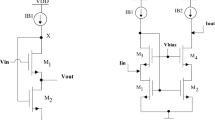Abstract
In this paper, complete analysis of temperature compensated self-bias current reference (SBCR) with BJT has been done. This circuit is capable of generating temperature insensitive low currents in microampere range. This current reference is designed using first-order temperature-compensated MOS current reference and a BJT. It possesses simple structure, consumes low power and achieves high temperature insensitivity. The presented current reference has been simulated by TSMC model for 180 nm technology with the help of Mentor Graphics EldoSpice tool. For simulations, a supply voltage of 1.5 V has been used and power dissipated for 62.12 µA reference current has been observed to be 173.95 µW. Different values of reference currents have been obtained by varying aspect ratio of MOSFETs and/or supply voltage of the presented circuit. For a temperature range of − 30 °C to 100 °C, variations of only 2.2% have been observed in the presented SBCR. The robustness of the presented circuit against process parameters, supply voltage and temperature variations has been demonstrated using Monte Carlo, Corner and PVT analysis. A temperature insensitive flipped voltage follower has been designed using the presented SBCR.













Similar content being viewed by others
References
Abdallah B, Kakhia M, Alssadat W, Rihawy MS (2019) Deposition of Ti6Al4V thin films by DC magnetron sputtering: effect of the current on structural, corrosion and mechanical properties. Iran J Sci Technol Trans A Sci 43:1957–1965
Aggarwal B, Arora Y, Dhona JK (2021) Bandgap current reference using widlar current source. Indian J Eng Mater Sci 27(4):934–938
Al-Khazzar AAA (2016) Behavior of four solar PV modules with temperature variation. Int J Renew Energy Res 6(3):1091–1099
Badillo DA (2002) 1.5 V CMOS current reference with extended temperature operating range. In: Proc ISCAS. pp III-197–III-200
Bendali A, Audet Y (2007) A 1-V CMOS current reference with temperature and process compensation. IEEE Trans Circuits Syst I Reg Papers 54:1424–1429. https://doi.org/10.1109/TCSI.2007.900176
Carvajal RG, Ramirez-Angulo J, Lopez-Martin AJ, Torralba A, Galan JAG, Carlosena A, Chavero FM (2005) The flipped voltage follower: a useful cell for low-voltage low-power circuit design. IEEE Trans Circuits Syst I Regul Pap 52:1276–1291. https://doi.org/10.1109/tcsi.2005.851387
Chen J, Shi B (2003) 1 V CMOS current reference with 50 ppm/°C temperature coefficient. Electron Lett 39:209–210
Chun H, Lehmann T (2010) CMOS current reference generator using integrated resistors. Int Conf Electron Inf Eng 1:290–294
Devendra BK, Praveen BM, Tripathi VS, Nagaraju DH, Nayana KO (2021) Iran J Sci Technol Trans A Sci 45:1993–2000
Fiori F, Crovetti PS (2005) A new compact temperature-compensated CMOS current reference. IEEE Trans Circuits Syst II Express Briefs 52:724–728
Gray PR, Hurst PJ, Lewis SH, Meyer RG (2001) Analysis and design of analog integrated circuits. Wiley, New York
Green EDH (2014) Temperature dependence of semiconductor conductivity
Holberg DR, Allen PE (2007) CMOS analog circuit design (Oxford University Press)
Jose J, Ravindran A, Nair KK (2016) Study of temperature dependency on MOSFET parameter using MATLAB. Int Res J Eng Technol 3(7)
Kaminska Β, Arabi Κ, Bell I, Goteti P, Heurtas JL, Kim Β, Rueda A, Soma M (1997) Analog and mixed-signal benchmark circuits—first release. IEEE Proc Int Test Conf 1997:183–190. https://doi.org/10.1109/TEST.1997.639612
Kaur J, Mehta M (2015) Comparative analysis of different current mirror using 45 nm technology. Int J Recent Innov Trends Comput Commun 3:3853–3857
Lee CH, Park HJ (1996) All-CMOS temperature independent current reference. Electron Lett 32:1280–1281
Mnif, Hassene, et al (2002) A new approach for modelling the thermal behaviour of bipolar transistors. In: Proceedings of the fourth IEEE international Caracas conference on devices, circuits and systems (Cat. No. 02TH8611). IEEE
Razavi B (2001) Design of analog CMOS integrated circuits. McGraw-Hill, New York
Rincon-Mora GA, Alfanso G (2002) Voltage references: from diodes to precision high-order bandgaps circuits. (eds) Alfanso G, Rincon-Mora GA (Wiley-IEEE Press, 2002) pp 41–60
Sansen W, Eynde F, Steyaert M (1987) A new CMOS current reference. In: 13th European solid-state circuits conference, Taunus-Tagungs-Zentrum, 1987(Taunus-Tagungs-Zentrum, Germany) pp 125–128
Sedra AS, Smith KC (2006) Microelectronic circuits. Oxford Univ. Press, London, UK
Severe LC, Noije WAMV (2016) An optimization-based design methodology with PVT analysis for ultra-low voltage analog ICs. In: 12th conference on Ph.D. research in microelectronics and electronics (PRIME). (Lisbon, Portugal, 2016) pp 1–4
Toumazou C, Lidgey FJ, Haigh DG (1990) Analogue IC design: the current mode approach. Peter Peregrinus Ltd., UK
Wang Y, Chen D, Geiger RL (2014) A CMOS supply-insensitive with 13ppm/°C temperature coefficient current reference. In: IEEE 57th International Midwest Symposium on Circuits and Systems (MWSCAS), College Station, 2014 (College Station, TX) pp 475–478
Widlar RJ (1971) New developments in IC voltage regulators. IEEE Solid-State Circuits. https://doi.org/10.1109/JSSC.1971.1050151
Yang BD (2009) An accurate current reference using temperature and process compensation current mirror. Proc IEEE Asian Solid-State Circuits Conf. https://doi.org/10.1109/ASSCC.2009.5357223
Zhao C, Geiger R, Chen D (2012) A compact low-power supply-insensitive CMOS current reference. Proc IEEE Int Symp Circuits Syst. https://doi.org/10.1109/ISCAS.2012.6271899
Author information
Authors and Affiliations
Corresponding author
Rights and permissions
Springer Nature or its licensor (e.g. a society or other partner) holds exclusive rights to this article under a publishing agreement with the author(s) or other rightsholder(s); author self-archiving of the accepted manuscript version of this article is solely governed by the terms of such publishing agreement and applicable law.
About this article
Cite this article
Arora, Y., Aggarwal, B. & Kaur, J. Analysis of Self-Bias Current Reference with BJT and its Application in Flipped Voltage Follower. Iran J Sci Technol Trans Electr Eng 47, 813–824 (2023). https://doi.org/10.1007/s40998-023-00590-0
Received:
Accepted:
Published:
Issue Date:
DOI: https://doi.org/10.1007/s40998-023-00590-0




